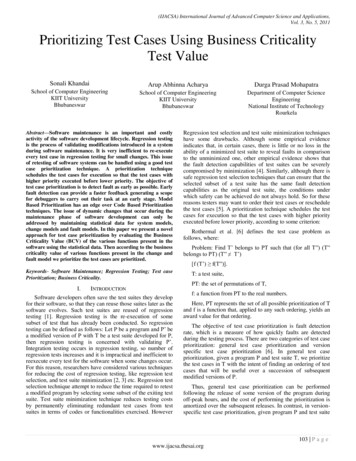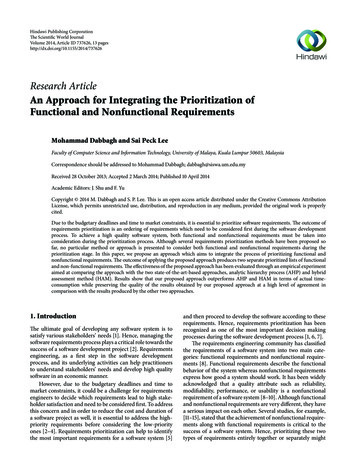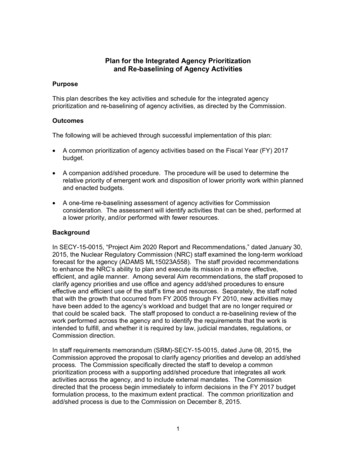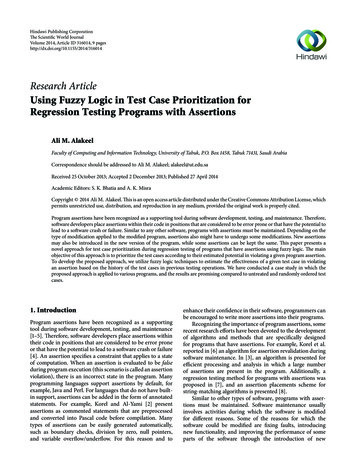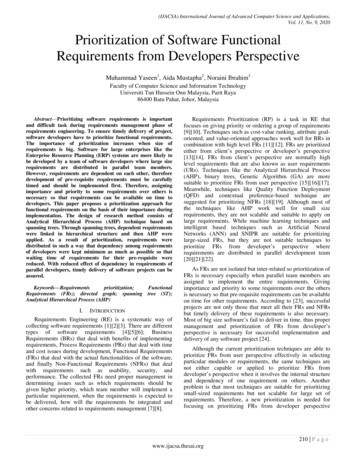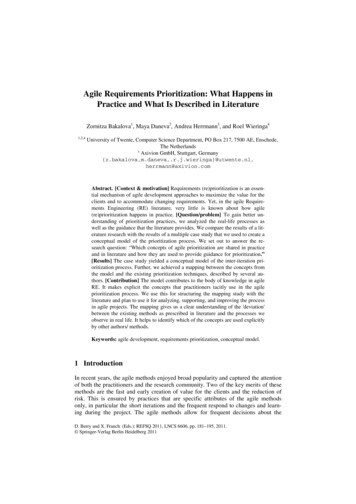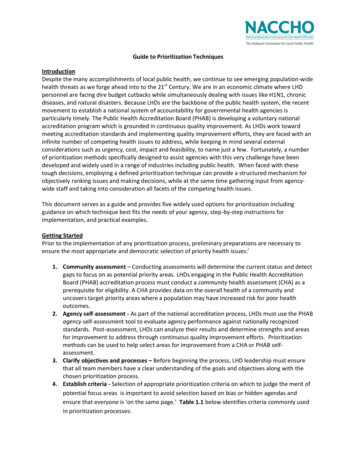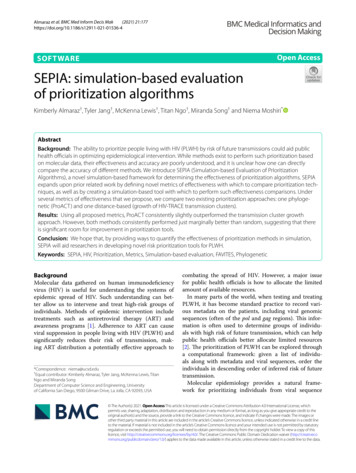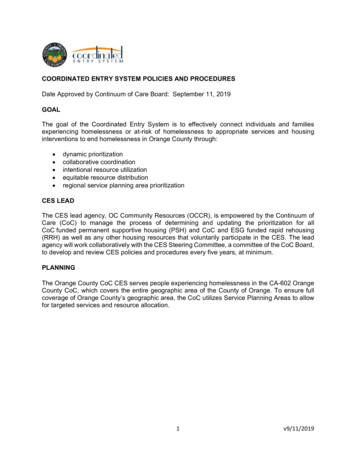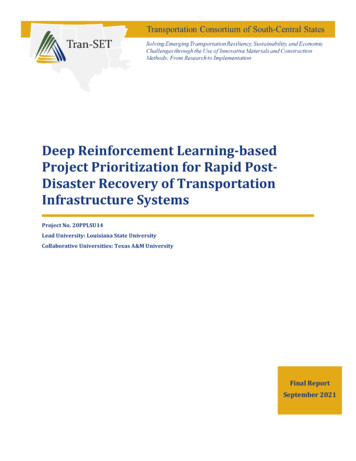
Transcription
in Engineering and Managing Software Requirements, edited by A. Aurum and C. Wohlin, Springer Verlag4 Requirements PrioritizationPatrik Berander and Anneliese AndrewsAbstract: This chapter provides an overview of techniques for prioritization ofrequirements for software products. Prioritization is a crucial step towards makinggood decisions regarding product planning for single and multiple releases. Various aspects of functionality are considered, such as importance, risk, cost, etc. Prioritization decisions are made by stakeholders, including users, managers, developers, or their representatives. Methods are given how to combine individualprioritizations based on overall objectives and constraints. A range of differenttechniques and aspects are applied to an example to illustrate their use. Finally,limitations and shortcomings of current methods are pointed out, and open research questions in the area of requirements prioritization are discussed.Keywords: Requirements analysis, software product planning, requirements prioritization, decision support, trade offs.4.1 IntroductionIn everyday life, we make many decisions, e.g. when buying a DVD-player, food,a telephone, etc. Often, we are not even conscious of making one. Usually, we donot have more than a couple of choices to consider, such as which brand of mustard to buy, or whether to take this bus or the next one. Even with just a couple ofchoices, decisions can be difficult to make. When having tens, hundreds or eventhousands of alternatives, decision-making becomes much more difficult.One of the keys to making the right decision is to prioritize between different alternatives. It is often not obvious which choice is better, because several aspectsmust be taken into consideration. For example, when buying a new car, it is relatively easy to make a choice based on speed alone (one only needs to evaluatewhich car is the fastest). When considering multiple aspects, such as price, safety,comfort, or luggage load, the choice becomes much harder. When developing software systems, similar trade-offs must be made. The functionality that is most important for the customers might not be as important when other aspects (e.g. price)are factored in. We need to develop the functionality that is most desired by thecustomers, as well as least risky, least costly, and so forth.Prioritization helps to cope with these complex decision problems. This chapterprovides a description of available techniques and methods, and how to approacha prioritization situation. The chapter is structured as follows: First, an overviewof the area of prioritization is given (Section 4.2). This is followed by a presentation and discussion of different aspects that could be used when prioritizing (Sec-
tion 4.3). Next, some prioritization techniques and characteristics are discussed(Section 4.4), followed by a discussion of different stakeholders’ situations that affect prioritization in Section 4.5. Section 4.6 discusses additional issues that arisewhen prioritizing software requirements and Section 4.7 provides an example of aprioritization. Section 4.8 discusses possible future research questions in the area.Finally, Section 4.9 summarizes the chapter.4.2 What is Requirements Prioritization?Complex decision-making situations are not unique to software engineering. Otherdisciplines, such as psychology, and organizational behavior have studied decision-making thoroughly [1]. Classical decision-making models have been mappedto various requirements engineering activities to show the similarities [1]. Chapter12 in this book provides a comprehensive overview of decision-making and decision support in requirements engineering. Current chapter primarily focuses on requirements prioritization, an integral part of decision-making [49]. The intention isto describe the current body of knowledge in the requirements prioritization area.The quality of a software product is often determined by the ability to satisfy theneeds of the customers and users [7, 53]. Hence, eliciting (Chapter 2) and specifying (Chapter 3) the correct requirements and planning suitable releases with theright functionality is a major step towards the success of a project or product. Ifthe wrong requirements are implemented and users resist using the product, it doesnot matter how solid the product is or how thoroughly it has been tested.Most software projects have more candidate requirements than can be realizedwithin the time and cost constraints. Prioritization helps to identify the most valuable requirements from this set by distinguishing the critical few from the trivialmany. The process of prioritizing requirements provides support for the followingactivities (e.g. [32, 55, 57, 58]): for stakeholders to decide on the core requirements for the system. to plan and select an ordered, optimal set of software requirements for implementation in successive releases. to trade off desired project scope against sometimes conflicting constraints suchas schedule, budget, resources, time to market, and quality. to balance the business benefit of each requirement against its cost. to balance implications of requirements on the software architecture and futureevolution of the product and its associated cost. to select only a subset of the requirements and still produce a system that willsatisfy the customer(s). to estimate expected customer satisfaction. to get a technical advantage and optimize market opportunity. to minimize rework and schedule slippage (plan stability). to handle contradictory requirements, focus the negotiation process, and resolvedisagreements between stakeholders (more about this in Chapter 7).
to establish relative importance of each requirement to provide the greatestvalue at the lowest cost.The list above clearly shows the importance of prioritizing and deciding whatrequirements to include in a product. This is a strategic process since these decisions drive the development expenses and product revenue as well as making thedifference between market gain and market loss [1]. Further, the result of prioritization might form the basis of product and marketing plans, as well as being adriving force during project planning. Ruhe et al. summarize this as: “The challenge is to select the ‘right’ requirements out of a given superset of candidate requirements so that all the different key interests, technical constraints and preferences of the critical stakeholders are fulfilled and the overall business value of theproduct is maximized” [48].Of course, it is possible to rectify incorrect decisions later on via change management (more about change impact analysis in Chapter 6), but this can be verycostly since it is significantly more expensive to correct problems later in the development process [5]. Frederick P. Brooks puts it in the following words: “Thehardest single part of building a software system is deciding precisely what tobuild. [ ] No other part of the work so cripples the resulting system if donewrong. No other part is more difficult to rectify later.” [10]. Hence, the most costeffective way of developing software is to find the optimal set of requirementsearly, and then to develop the software according to this set. To accomplish this, itis crucial to prioritize the requirements to enable selection of the optimal set.Besides the obvious benefits presented above, prioritizing requirements canhave other benefits. For example, it is possible to find requirements defects (e.gmisjudged, incorrect, and ambiguous requirements) since requirements are analyzed from a perspective that is different from that taken during reviews of requirements [33].Some authors consider requirements prioritization easy [55], some regard it ofmedium difficulty [57], and some regard prioritization as one of the most complexactivities in the requirements process, claiming that few software companies haveeffective and systematic methods for prioritizing requirements [40]. However, allthese sources consider requirements prioritization a fundamental activity for project success. At the same time, some text books about requirements engineering(e.g [9, 47]) do not discuss requirements prioritization to any real extent.There is no “right” requirements process and the way of handling requirementsdiffers greatly between different domains and companies [1]. Further, requirements are typically vaguer early on and become more explicit as the understandingof the product grows [50]. These circumstances imply that there is no specificphase where prioritization is made, rather, it is performed throughout the development process (more about this in Section 4.6.2) [13, 38]. Hence, prioritization isan iterative process and might be performed at different abstraction levels andwith different information in different phases during the software lifecycle.Prioritization techniques can roughly be divided into two categories: methodsand negotiation approaches. The methods are based on quantitatively assigningvalues to different aspects of requirements while negotiation approaches focus ongiving priorities to requirements by reaching agreement between different stake-
holders [39]. Further, negotiation approaches are based on subjective measuresand are commonly used when analyses are contextual and when decision variablesare strongly interrelated. Quantitative methods make it easier to aggregate different decision variables into an overall assessment and lead to faster decisions [15,50]. In addition, one must be mindful of the social nature of prioritization. There ismore to requirements prioritization than simply asking stakeholders about priorities. Stakeholders play roles and should act according to the goals of that role, butthey are also individuals with personalities and personal agendas. Additionally,many organizational issues like power etc. need to be taken into account. Ignoringsuch issues can raise the risk level for a project. Negotiation and goal modelingare described in detail in Chapter 7 and 9, respectively, while this chapter focusesprimarily on quantitative methods for prioritizing requirements.4.3 Aspects of PrioritizationRequirements can be prioritized taking many different aspects into account. Anaspect is a property or attribute of a project and its requirements that can be usedto prioritize requirements. Common aspects are importance, penalty, cost, time,and risk. When prioritizing requirements based on a single aspect, it is easy to decide which one is most desirable (recall the example about the speed of a car).When involving other aspects, such as cost, customers can change their mind andhigh priority requirements may turn out to be less important if they are very expensive to satisfy [36]. Often, the aspects interact and changes in one aspect couldresult in an impact on another aspect [50]. Hence, it is essential to know what effects such conflicts may have, and it is vital to not only consider importance whenprioritizing requirements but also other aspects affecting software developmentand satisfaction with the resulting product. Several aspects can be prioritized, andit may not be practical to consider them all. Which ones to consider depend on thespecific situation, and a few examples of aspects suitable for software projects aredescribed below. Aspects are usually evaluated by stakeholders in a project (managers, users, developers, etc.)4.3.1 ImportanceWhen prioritizing importance, the stakeholders should prioritize which requirements are most important for the system. However, importance could be an extremely multifaceted concept since it depends very much on which perspective thestakeholder has. Importance could for example be urgency of implementation, importance of a requirement for the product architecture, strategic importance for thecompany, etc. [38]. Consequently, it is essential to specify which kind of importance the stakeholders should prioritize in each case.
4.3.2 PenaltyIt is possible to evaluate the penalty that is introduced if a requirement is not fulfilled [57]. Penalty is not just the opposite of importance. For example, failing toconform to a standard could incur a high penalty even if it is of low importance forthe customer (i.e. the customer does not get excited if the requirement is fulfilled).The same goes for implicit requirements that users take for granted, and whose absence could make the product unsuitable for the market.4.3.3 CostThe implementation cost is usually estimated by the developing organization.Measures that influence cost include: complexity of the requirement, the ability toreuse existing code, the amount of testing and documentation needed, etc. [57].Cost is often expressed in terms of staff hours (effort) since the main cost in software development is often primarily related to the number of hours spent. Cost (aswell as time, cf. Section 4.3.4.) could be prioritized by using any of the techniquespresented in Section 4.4, but also by simply estimating the actual cost on an absolute or normalized scale.4.3.4 TimeAs can be seen in the section above, cost in software development is often relatedto number of staff hours. However, time (i.e. lead time) is influenced by manyother factors such as degree of parallelism in development, training needs, need todevelop support infrastructure, complete industry standards, etc. [57].4.3.5 RiskEvery project carries some amount of risk. In project management, risk management is used to cope with both internal (technical and market risks) and externalrisks (e.g. regulations, suppliers). Both likelihood and impact must be consideredwhen determining the level of risk of an item or activity [44]. Risk managementcan also be used when planning requirements into products and releases by identifying risks that are likely to cause difficulties during development [41, 57]. Suchrisks could for example include performance risks, process risks, schedule risksetc. [55]. Based on the estimated risk likelihood and risk impact for each requirement [1], it is possible to calculate the risk level of a project.
4.3.6 VolatilityVolatility of requirements is considered a risk factor and is sometimes handled aspart of the risk aspect [41]. Others think that volatility should be analyzed separately and that volatility of requirements should be taken into account separately inthe prioritization process [36]. The reasons for requirements volatility vary, forexample: the market changes, business requirements change, legislative changesoccur, users change, or requirements become more clear during the software lifecycle [18, 50]. Irrespective of the reason, volatile requirements affect the stabilityand planning of a project, and presumably increase the costs since changes duringdevelopment increase the cost of a project (see more about this issue in Chapter6). Further, the cost of a project might increase because developers have to selectan architecture suited to change if volatility is known to be an issue [36].4.3.7 Other AspectsThe above list of aspects has been considered important in the literature but it isby no means exhaustive. Examples of other aspects are: financial benefit, strategicbenefit, competitors, competence/resources, release theme, ability to sell, etc. Fora company, we suggest that stakeholders develop a list of important aspects to usein the decision-making. It is important that the stakeholders have the same interpretation of the aspects as well as of the requirements. Studies have shown that itis hard to interpret the results if no guidelines about the true meaning of an aspectare present [37, 38].4.3.8 Combining Different AspectsIn practice, it is important to consider multiple aspects before deciding if a requirement should be implemented directly, later, or not at all. For example, in theCost-Value approach, both value (importance) and cost are prioritized to implement those requirements that give most value for the money [30]. The PlanningGame (from XP) uses a similar approach when importance, effort (cost), and risksare prioritized [2]. Further, importance and stability (volatility) are suggested asaspects that should be used when prioritizing while others suggest that dependencies also must be considered [12, 36] (more about dependencies in Chapter 5). InWiegers’ approach, the relative value (importance) is divided by the relative costand the relative risk in order to determine the requirements that have the most favorable balance of value, cost, and risk [57]. This approach further allows different weights for different aspects in order to favor the most important aspect (in thespecific situation).There are many alternatives of combining different aspects. Which aspects toconsider depend very much on the specific situation and it is important to knowabout possible aspects and how to combine them efficiently to suit the case athand.
4.4 Prioritization TechniquesThe purpose of any prioritization is to assign values to distinct prioritization objects that allow establishment of a relative order between the objects in the set. Inour case, the objects are the requirements to prioritize. The prioritization can bedone with various measurement scales and types. The least powerful prioritizationscale is the ordinal scale, where the requirements are ordered so that it is possibleto see which requirements are more important than others, but not how much moreimportant. The ratio scale is more powerful since it is possible to quantify howmuch more important one requirement is than another (the scale often ranges from0 - 100 percent). An even more powerful scale is the absolute scale, which can beused in situations where an absolute number can be assigned (e.g. number ofhours). With higher levels of measurement, more sophisticated evaluations andcalculations become possible [20].Below, a number of different prioritization techniques are presented. Sometechniques assume that each requirement is associated with a priority, and othersgroup requirements by priority level. When examples are given, importance isused as the aspect to prioritize even though other aspects can be evaluated witheach of the techniques. It should be noted that the presented techniques focus specifically on prioritization. Numerous methods exist that use these prioritizationtechniques within a larger trade-off and decision making framework (e.g.EVOLVE [24], Cost-Value [30] and Quantitative Win-Win [48]).4.4.1 Analytical Hierarchy Process (AHP)The Analytic Hierarchy Process (AHP) is a systematic decision-making methodthat has been adapted for prioritization of software requirements [45, 51]. It isconducted by comparing all possible pairs of hierarchically classified requirements, in order to determine which has higher priority, and to what extent (usuallyon a scale from one to nine where one represents equal importance and nine represents absolutely more important). The total number of comparisons to performwith AHP are n (n-1)/2 (where n is the number of requirements) at each hierarchy level, which results in a dramatic increase in the number of comparisons asthe number of requirements increases. Studies have shown that AHP is not suitable for large numbers of requirements [39, 42]. Researchers have tried to findways to decrease the number of comparisons (e.g. [26, 54]) and variants of thetechnique have been found to reduce the number of comparisons by as much as 75percent [31].In its original form, the redundancy of the pair-wise comparisons allows a consistency check where judgment errors can be identified and a consistency ratio canbe calculated. When reducing the number of comparisons, the number of redundant comparisons are also reduced, and consequently the ability to identify inconsistent judgments [33]. When using other techniques (explained below) a consistency ratio is not necessary since all requirements are directly compared to eachother and consistency is always ensured. Some studies indicate that persons who
prioritize with AHP tend to mistrust the results since control is lost when onlycomparing the requirements pair-wise [34, 39]. The result from a prioritizationwith AHP is a weighted list on a ratio scale. More detailed information about AHPcan be found in [30], [51] and [52].4.4.2 Cumulative Voting, the 100-Dollar TestThe 100-dollar test is a very straightforward prioritization technique where thestakeholders are given 100 imaginary units (money, hours, etc.) to distribute between the requirements [37]. The result of the prioritization is presented on a ratioscale. A problem with this technique arises when there are too many requirementsto prioritize. For example, if you have 25 requirements, there are on average fourpoints to distribute for each requirement. Regnell et al. faced this problem whenthere were 17 groups of requirements to prioritize [45]. In the study, they used afictitious amount of 100,000 to have more freedom in the prioritizations. Thesubjects in the study were positive about the technique, indicating the possibilityto use amounts other than 100 units (e.g. 1,000, 10,000 or 1 000,000). Anotherpossible problem with the 100-dollar test (especially when there are many requirements) is that the person performing the prioritization miscalculates and thepoints do not add up to 100 [3]. This can be prevented by using a tool that keepscount of how many points have been used.One should only perform the prioritization once one the same set of requirements, since the stakeholders might bias their evaluation the second time around ifthey do not get one of their favorite requirements as a top priority. In such a situation, stakeholders could put all their money on one requirement, which might influence the result heavily. Similarly, some clever stakeholders might put all theirmoney on a favorite requirement that others do not prioritize as highly (e.g. Maccompatibility) while not giving money to requirements that will get much moneyanyway (e.g. response time). The solution could be to limit the amount spent onindividual requirements [37]. However, the risk with such an approach is thatstakeholders may be forced to not prioritize according to their actual priorities.4.4.3 Numerical Assignment (Grouping)Numerical assignment is the most common prioritization technique and is suggested both in RFC 2119 [8] and IEEE Std. 830-1998 [29]. The approach is basedon grouping requirements into different priority groups. The number of groups canvary, but in practice, three groups are very common (e.g. [37, 55]). When usingnumerical assignment, it is important that each group represents something thatthe stakeholders can relate to (e.g. critical, standard, optional), for a reliable classification. Using relative terms such as high, medium, and low will confuse thestakeholders [57]. This seems to be especially important when there are stakeholders with different views of what high, medium and low means. A clear definition of what a group really means minimizes such problems.
A further potential problem is that stakeholders tend to think that everything iscritical [36, 55]. If customers prioritize themselves, using three groups; critical,standard, and optional, they will most likely consider 85 percent of the requirements as critical, 10 percent as standard, and 5 percent as optional [4, 57]. Oneidea is to put restrictions on the allowed number of requirements in each group(e.g. not less than 25 percent of the requirements in each group) [34]. However,one problem with this approach is that the usefulness of the priorities diminishesbecause the stakeholders are forced to divide requirements into certain groups[32]. However, no empirical evidence of good or bad results with such restrictionsexists. The result of numerical assignment is requirements prioritized on an ordinal scale. However, the requirements in each group have the same priority, whichmeans that each requirement does not get a unique priority.4.4.4 RankingAs in numerical assignment, ranking is based on an ordinal scale but the requirements are ranked without ties in rank. This means that the most important requirement is ranked 1 and the least important is ranked n (for n requirements).Each requirement has a unique rank (in comparison to numerical assignment) butit is not possible to see the relative difference between the ranked items (as inAHP or the 100-dollar test). The list of ranked requirements could be obtained in avariety of ways, as for example by using the bubble sort or binary search tree algorithms [33]. Independently of sorting algorithm, ranking seems to be more suitablefor a single stakeholder because it might be difficult to align several differentstakeholders’ views. Nevertheless, it is possible to combine the different views bytaking the mean priority of each requirement but this might result in ties for requirements which this method wants to avoid.4.4.5 Top-Ten RequirementsIn the top-ten requirements approach, the stakeholders pick their top-ten requirements (from a larger set) without assigning an internal order between the requirements. This makes the approach especially suitable for multiple stakeholders ofequal importance [36]. The reason to not prioritize further is that it might createunnecessary conflict when some stakeholders get support for their top priority andothers only for their third priority. One could assume that conflicts might ariseanyway if, for example, one customer gets three top-ten requirements into theproduct while another gets six top-ten requirements into the product. However, itis important to not just take an average across all stakeholders since it might leadto some stakeholders not getting any of their top requirements [36]. Instead, it iscrucial that some essential requirements are satisfied for each stakeholder. Thiscould obviously result in a situation that dissatisfies all customers instead of satisfying a few customers completely. The main challenge in this technique is to balance these issues.
4.4.6 Which Prioritization Technique to ChooseTable 4.1 summarizes the presented prioritization techniques, based on measurement scale, granularity of analysis, and level of sophistication of the technique.Table 4. 1. Summary of Presented Techniques.TechniqueAHPHundred-dollar testRankingNumerical nularityFineFineMediumCoarseExtremely CoarseSophisticationVery ComplexComplexEasyVery EasyExtremely EasyA general advice is to use the simplest appropriate prioritization technique anduse more sophisticated ones when a more sensitive analysis is needed for resolving disagreements or to support the most critical decisions [42]. As more sophisticated techniques generally are more time consuming, the simplest possible technique ensures cost effective decisions. The trade-off is to decide exactly how“quick and dirty” the approach can be without letting the quality of the decisionssuffer. It should also be noted that there exist several commercial tools that facilitate the use of more sophisticated techniques (e.g. AHP) and that it is possible toconstruct simple home-made tools (e.g. in spreadsheets) to facilitate the use of different prioritization techniques.4.4.7 Combining Different TechniquesThe techniques in Table 4.1 represent the most commonly referenced quantitativeprioritization techniques. It is possible to combine some of them to make prioritization easier or more efficient. Some combinations of the above techniques existand probably the best known example is Planning Game (PG) in eXtreme Programming (XP) [2] (more about agile methods in requirements engineering inChapter 14). In PG, numerical assignment and ranking are combined by first dividing the different requirements into priority groups and then ranking requirements within each group [34]. Requirements triage is an approach where parallelsare drawn to medical treatment at hospitals [17]. Medical personnel divide victimsinto three categories: those that will die whether treated or not, those who will resume normal lives whether treated or not, and those for whom medical treatmentmay make a significant difference. In requirements prioritization, there are requirements that must be in the product (e.g. platform requirements), requirementsthat the product clearly need not satisfy (e.g. very optional requirements), and requirements that need more attention. This means that the requirements are assigned to one of three groups (numerical assignment) and requirements that needmore attention are prioritized by any of the other techniques (AHP, ranking, 100
points etc.). In this approach, not all requirements must be prioritized by a moresophisticated technique, which decreases the effort.The two examples above show that it is possible to combine different techniquesfor higher efficiency or to make the process easier. Which method or combinationof methods is suitable often depends on the individual project.4.5 Involved Stakeholders in the Prioritization ProcessIn Chapter 13, market-driven software development is discussed and similaritiesand differences between market-driven and bespoke software development arepresented. As can be seen in Chapter 13, similarities and differences also applywhen prioritizing software requirements. In a bespoke project, only one or a fewstakeholders must be taken into consideration while everyone in the whole worldmight serve as potential customers in market-driven development. Table 4.2 outlines some of the differences between market-driven and bespoke developmentthat affects requirements prioritization.Table 4. 2. Differences between Market-driven and Bespoke Development [11].FacetMain stakeholderUsersBespoke DevelopmentCustomer organizationKnown or identifiableDistance to usersRequirements ConceptionUsually smallElicited, analyzed, validatedOne release, then maintenanceElicitation, modeling,validation,
ent decision variables into an overall assessment and lead to faster decisions [15, 50]. In addition, one must be mindful of the social nature of prioritization. There is more to requirements prioritization than simply asking stakeholders about priori-ties. Stakeholders play roles and should act according to the goals of that role, but
